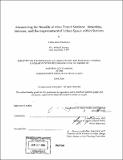| dc.contributor.advisor | J. Mark Schuster. | en_US |
| dc.contributor.author | Montañez, Carlos Javier, 1975- | en_US |
| dc.contributor.other | Massachusetts Institute of Technology. Dept. of Urban Studies and Planning. | en_US |
| dc.date.accessioned | 2005-06-02T18:16:56Z | |
| dc.date.available | 2005-06-02T18:16:56Z | |
| dc.date.issued | 2004 | en_US |
| dc.identifier.uri | http://hdl.handle.net/1721.1/17693 | |
| dc.description | Thesis (M.C.P.)--Massachusetts Institute of Technology, Dept. of Urban Studies and Planning, 2004. | en_US |
| dc.description | "June 2004." | en_US |
| dc.description | Includes bibliographical references (leaf 88). | en_US |
| dc.description.abstract | Little attention has been paid to the quality of the spaces within rapid mass transit stations in the United States, and their importance as places in and of themselves. For many city dwellers who rely on rapid transit service as their primary mode of travel, descending and ascending into and from transit stations is an integral part of daily life and their urban experience. Beyond being simply a piece of infrastructure offering mobility throughout a city, transit stations are an important part of the daily morning and evening rituals for many transit riders in cities with such rapid transit systems. Given their importance, it is surprising how underutilized are the interiors of stations as well as how poorly stations reveal what lies within their walls. The purpose of this thesis is to examine how ancillary uses affect the station environment; how non-elevated mass rapid transit stations within the Massachusetts Bay Transportation Area (MBTA) system are being improved through ancillary uses; which uses are particularly beneficial to transit authorities and riders alike as well as which uses require additional operations considerations; and to make suggestions as to how to further improve the station environments through the continued use of ancillary uses. | en_US |
| dc.description.statementofresponsibility | by Carlos Javier Montañez. | en_US |
| dc.format.extent | 88 leaves | en_US |
| dc.format.extent | 3251202 bytes | |
| dc.format.extent | 3251009 bytes | |
| dc.format.mimetype | application/pdf | |
| dc.format.mimetype | application/pdf | |
| dc.language.iso | eng | en_US |
| dc.publisher | Massachusetts Institute of Technology | en_US |
| dc.rights | M.I.T. theses are protected by copyright. They may be viewed from this source for any purpose, but reproduction or distribution in any format is prohibited without written permission. See provided URL for inquiries about permission. | en_US |
| dc.rights.uri | http://dspace.mit.edu/handle/1721.1/7582 | |
| dc.subject | Urban Studies and Planning. | en_US |
| dc.title | Maximizing the benefits of mass transit stations : amenities, services, and the improvement of urban space within spaces | en_US |
| dc.type | Thesis | en_US |
| dc.description.degree | M.C.P. | en_US |
| dc.contributor.department | Massachusetts Institute of Technology. Department of Urban Studies and Planning | |
| dc.identifier.oclc | 56403283 | en_US |
